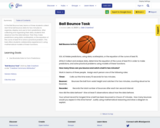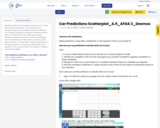
Introduction to Logarithmic Functions as Inverse of an Exponential - Mathematics Instructional Plan
- Subject:
- Mathematics
- Material Type:
- Lesson Plan
- Provider:
- VDOE
- Author:
- VDOE
- Date Added:
- 10/07/2024

Resources to support Mathematics Standards of Learning for Algebra, Functions, and Data Analysis

Introduction to Logarithmic Functions as Inverse of an Exponential - Mathematics Instructional Plan

Reflecting, Dilating, and Translating Functions - Mathematics Instructional Plan

Comparing Linear and Exponential Models - Mathematics Instructional Plan

Modeling Data Using an Appropriate Function - Mathematics Instructional Plan

Exploring Exponential Models - Mathematics Instructional Plan

Determining Lines of Best Fit - Mathematics Instructional Plan

Exploration of Curve of Best Fit - Mathematics Instructional Plan

Introduction to Scatterplots and Regression - Mathematics Instructional Plan

Determine Optimal Values by Identifying Constraints and Using Linear Programming Techniques - Mathematics Instructional Plan

Analyzing probability of events through Venn diagrams - Mathematics Instructional Plan

Differentiate between type of events - Mathematics Instructional Plan

Calculate probabilities - Mathematics Instructional Plan

Calculate probabilities - Mathematics Instructional Plan

Surveying and Polling - Mathematics Instructional Plan

Determining the Curve of Best Fit for Quadratic Functions and Models - Mathematics Instructional Plan

Analyzing probability of events through Venn diagramsMathematics Instructional Plans (MIPs) help teachers align instruction with the 2016 Mathematics Standards of Learning (SOL) by providing examples of how the knowledge, skills and processes found in the SOL and curriculum framework can be presented to students in the classroom.

In the Ball Bounce task, teams of three students collect real-time ball bounce data for two minutes to organize, display and use to form predictions. After collecting and organizing their data, students first observe how the data behave. Then they make predictions using data, scatterplots, or the equation of the curve of best fit to solve a
practical problem. This task offers students collaborative experience in using mathematical models of linear functions.

Normal Distribution Mathematics Instructional Plans (MIPs) help teachers align instruction with the 2016 Mathematics Standards of Learning (SOL) by providing examples of how the knowledge, skills and processes found in the SOL and curriculum framework can be presented to students in the classroom.

Students research two variables about the car model they intend to purchase. They use Desmos to compare these same variables across five different car models. Students use analysis of bivariate data in order to decide which car makes sense to buy. Students prepare and share a summary statement and include desmos screen shots in order to justify their purchase. This task offers students experiences in making predictions, using data, scatterplots, or the equation of the curve of best fit for decision-making in a practical problem.

AFDA Catapults and Quadratic Regression Co-Teaching MIP